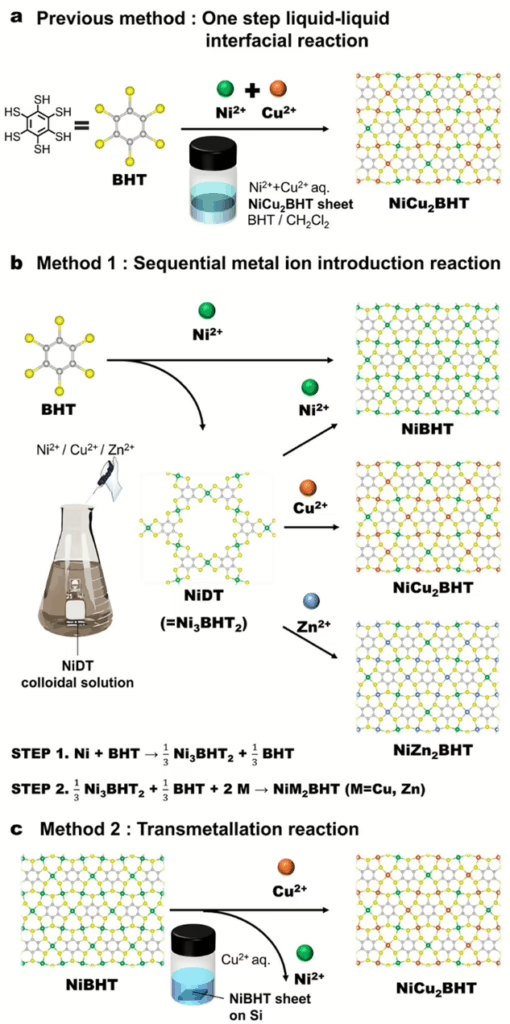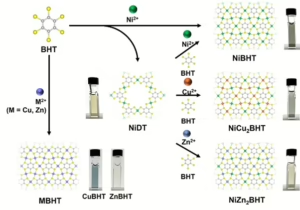A transformative approach to the development of heterometallic coordination nanosheets (CONASHs), a unique class of 2D materials with the potential to revolutionize display technology and other flexible electronics, has been introduced by a team of researchers at Tokyo University of Science, led by Professor Hiroshi Nishihara. This new research provides a scalable, ink-based production method that has the potential to revolutionize the next generation of high-performance, flexible, and printable electronic devices.
Nanosheets are ultrathin materials that are comprised of planar organic ligands, such as benzenehexathiol (BHT), that are linked with transition metal ions through coordination bonds. These nanosheets are already recognized for their exceptional optical properties, redox activity, and conductivity, which render them desirable for energy devices, sensors, and catalysis. Nevertheless, their synthesis has been historically restricted to homometallic structures that involve a single type of metal ion, such as nickel (Ni), and to complex two-phase reactions.

Professor Nishihara’s team has recently developed a single-phase synthetic method that facilitates the formation of highly conductive colloidal coordination nanosheets that are well-organized. By manipulating the molar ratio of Ni²⁺ ions and BHT, the researchers were able to selectively generate either porous NiDT (nickelladithiolene) or non-porous NiBHT nanosheets, thereby providing a high degree of control over the function and structure.
The capacity to employ these colloidal solutions as functional dyes is even more innovative. Conventional printing techniques can be employed to scale production by coating these pigments onto substrates such as glassy carbon (GC). Electrochemical testing demonstrated that NiDT-coated electrodes are effective catalysts for hydrogen evolution and exhibit significant redox activity, which are essential for energy and sensing applications.
The team broadened their research to include heterometallic coordination nanosheets (HMCONASHs) in order to address the constraints of single-metal systems. These nanosheets incorporate numerous metal ions, including copper (Cu²⁺) and zinc (Zn²⁺), in addition to nickel. The researchers were able to form heterometallic nanosheets such as NiCu₂BHT and NiZn₂BHT by incorporating Cu²⁺ or Zn²⁺ ions into the NiDT framework by utilizing unreacted BHT present in the NiDT colloidal solutions.
Transmetallation, a strategy that involves the exchange of metal ions in existing structures for various ions, resulted in additional innovation. The team effectively synthesized NiCu₂BHT, a heterometallic nanosheet with superior electrical conductivity and enhanced crystallinity, by introducing Cu²⁺ ions to NiBHT. This nanosheet outperformed its homometallic counterpart. HMCONASHs are extremely attractive for integration into flexible electronics and optical applications due to their enhanced physical properties.
This development has substantial implications for the flat panel display (FPD) industry, particularly as manufacturers pursue alternatives to the current materials that are frequently unsustainable, costly, or brittle.
- Scalable, Flexible, and Printable
Large-scale fabrication is facilitated by the capacity to generate conductive nanosheets as pigments through printing technologies like inkjet or screen printing. This makes them well-suited for the development of flexible or foldable displays, which helps to reduce manufacturing costs and create more lightweight, durable devices. - A Realistic Substitute for ITO
One of the most promising applications is in transparent conductive electrodes, where materials such as Indium Tin Oxide (ITO) are widely used but are increasingly criticized for their brittleness and high cost. HMCONASHs, particularly those containing Cu and Ni, provide a conductive, transparent, and tunable alternative that is well-suited for use in e-paper displays, OLED panels, and next-generation touchscreens. - Enhanced Optoelectronic and Electrochromic Properties
These heterometallic nanosheets demonstrate dual redox-triggered multicolor electrochromism and broad absorption windows, which indicate potential applications in energy-efficient backlighting, dynamic color adjustment, and smart displays. Additionally, their electrochemical adaptability creates opportunities for the integration of energy storage or sensing functions within display components, thereby facilitating the development of multifunctional screen technologies. In the Direction of a Sustainable Future
Prof. Nishihara asserts that the initial ink produced from coordination nanosheets has enabled the direct application of the materials to devices and the mass production of them using printing technology. This represents a significant advancement in the practical application of the materials as hydrogen production catalysts, sensor materials, and next-generation flexible electronic devices. The Tokyo University of Science team has not only resolved long-standing obstacles to CONASH fabrication but also established these nanomaterials at the forefront of sustainable, scalable electronic innovation by employing a process that circumvents the intricacies of multi-phase synthesis and incorporates colloidal chemistry, metal ion modulation, and ink-based applications. With the increasing demand for energy-efficient, adaptable, and smart display technologies, the contributions of heterometallic coordination nanosheets, which are now printable, customizable, and high-performing, indicate a promising advancement in the development of greener, wiser electronics.
Reference
M. Ito, N. Fukui, K. Takada, Z. Yu, H. Maeda, K. Mizuno, H. Nishihara, Rationally Engineered Heterometallic Metalladithiolene Coordination Nanosheets with Defined Atomic Arrangements. Small 2025, 2503227. https://doi.org/10.1002/smll.202503227

